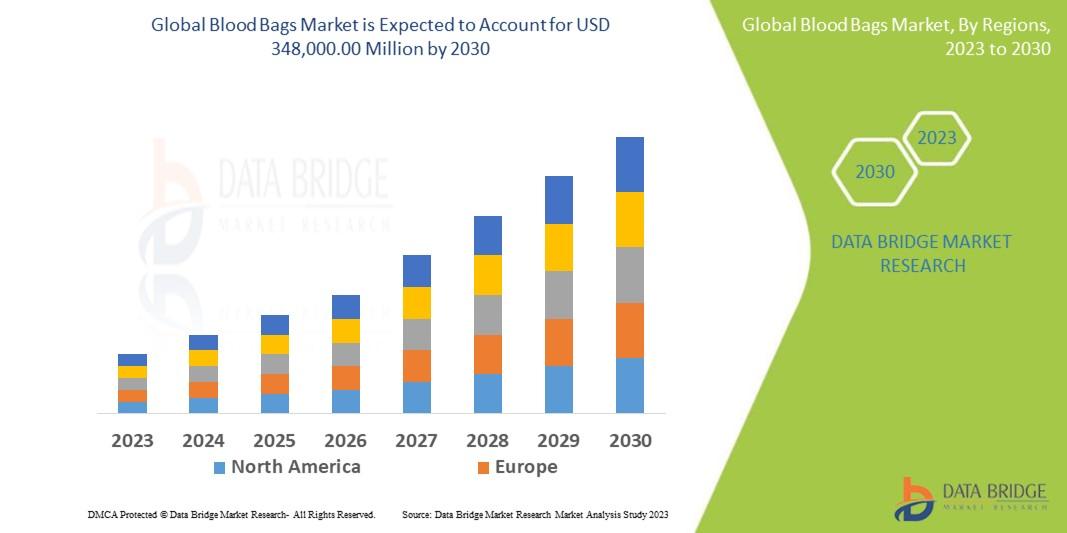Blood Bags Market: Life in a Bag – The Blood Bags Market Powering Safe Transfusions and Medical Innovation

The Blood Bags Market is a critical segment of the medical devices industry, driven primarily by the escalating demand for blood and blood components due to increasing surgical procedures, trauma cases, and the rising prevalence of chronic and blood-related disorders worldwide. Technological advancements in bag materials, such as the shift towards DEHP-free and PVC-free options, and the adoption of multi-component bags (triple, quadruple) are shaping market dynamics. The global market is witnessing steady growth, supported by rising awareness of voluntary blood donation and significant investments in healthcare infrastructure across emerging economies.
Market Overview
Blood bags are sterile, disposable, and flexible plastic containers used for collecting, storing, processing, and transfusing blood and its components (Red Blood Cells, Plasma, Platelets). They have largely replaced traditional glass bottles due to their superior safety, lower risk of contamination, and ease of use. Key factors driving market expansion include global initiatives for safer blood transfusion practices, increased funding for blood bank modernization, and the continuous need for component separation to maximize the utility of a single blood donation. The market is highly regulated, emphasizing product quality, sterility, and biocompatibility, which pushes manufacturers towards continuous innovation.
Market Size & Forecast
The global Blood Bags Market exhibited a valuation of approximately USD 385.0 Million in 2024. Leveraging a robust demand outlook and ongoing product innovation, the market is projected to reach an estimated value of USD 665.0 Million by 2032. This growth corresponds to a Compound Annual Growth Rate (CAGR) of approximately 7.1% during the forecast period of 2025–2032. The consistent increase in chronic disease management and complex surgical volumes globally serves as the primary impetus for this forecasted expansion.
Market Segmentation
The Blood Bags Market is comprehensively segmented across several key dimensions:
- By Product Type:
- Single Blood Bag: Dominates the market due to widespread use in routine whole blood collection and transfusion in primary care settings.
- Double Blood Bag
- Triple Blood Bag: Expected to witness rapid growth owing to increased practice of blood component separation (Red Cells and Plasma).
- Quadruple Blood Bag
- Penta Blood Bag
- By Material:
- Polyvinyl Chloride (PVC): PVC (with DEHP) remains the conventional material due to its cost-effectiveness and excellent gas barrier properties, ensuring a 42-day shelf life for RBCs.
- PVC (DEHP-free)
- Polyethylene Terephthalate (PET)
- Other Polymers (Polyolefin)
- By End-User:
- Hospitals & Clinics: Hold the highest revenue share due to high volume of surgical procedures and emergency care.
- Blood Banks
- Ambulatory Surgical Centers
- By Application:
- Collection Blood Bags: Largest segment, integral to the initial stage of blood banking.
- Transfer Blood Bags/Storage Blood Bags
- Processing Blood Bags
Regional Insights
- North America: Expected to maintain the largest market share (approx. 35-40%), driven by a highly advanced healthcare infrastructure, high healthcare expenditure, increasing incidence of chronic diseases, and the early adoption of advanced blood management systems, including automated and pathogen-reduction technologies.
- Europe: Holds a significant share, supported by stringent regulatory frameworks ensuring blood safety and a strong presence of key market players. The region is also at the forefront of adopting DEHP-free and environmentally sustainable materials.
- Asia-Pacific (APAC): Projected to be the fastest-growing region (CAGR exceeding 8.0%). This rapid growth is attributed to the fast-expanding patient base, rising government and private investment in healthcare infrastructure, increasing awareness of blood donation, and a large number of road accident and trauma cases. Countries like China and India are major contributors to this growth.
Competitive Landscape
The Blood Bags Market is moderately consolidated, dominated by a few global leaders who invest heavily in R&D for advanced product design and materials. Key strategies employed by players include product launches, strategic acquisitions, and geographical expansion, particularly into high-growth APAC markets.
Top Market Players:
- Terumo Corporation
- Fresenius SE & Co. KGaA
- Grifols S.A.
- Macopharma
- Haemonetics Corporation
- Kawasumi Laboratories, Inc.
- JMS Co., Ltd.
- Teleflex Incorporated
- Demophorius Healthcare Ltd.
- Suru International Pvt Ltd.
Trends & Opportunities
- Shift to DEHP-free and PVC-free Bags: Growing regulatory scrutiny and rising concerns over the toxicity of Di-Ethyl-Hexyl-Phthalate (DEHP) are spurring demand for non-PVC and alternative plasticizer materials, presenting a major opportunity for innovation.
- Integration of Smart Technologies: Adoption of technologies like RFID (Radio-Frequency Identification) tags and IoT-enabled sensors for real-time tracking of blood bags, monitoring temperature, and managing inventory, enhancing safety and efficiency.
- Increased Component Therapy: A growing focus on separating whole blood into components (platelets, plasma, red cells) drives the demand for multi-component bags (triple and quadruple) that facilitate sterile separation.
- Expansion in Emerging Markets: Untapped potential in high-growth regions like APAC and Latin America, where governments are investing heavily to strengthen public blood transfusion services.
Challenges & Barriers
- Stringent Regulatory Approvals: Strict guidelines from bodies like the FDA and EMA for blood product safety and material biocompatibility pose a significant hurdle for new product development and market entry.
- High Cost of Advanced Bags: The cost associated with manufacturing and procuring advanced blood bags (e.g., DEHP-free or integrated filter bags) can be prohibitive for healthcare institutions in low and middle-income countries, impacting adoption rates.
- Risk of Blood Contamination/Transfusion Reactions: Although rare, the possibility of bacterial contamination or transfusion-related adverse events remains a critical concern, necessitating continuous quality control and material safety improvements.
- Biohazardous Waste Disposal: The large volume of disposable plastic blood bags and related accessories generates substantial biohazardous waste, posing environmental and logistical challenges for disposal.
Conclusion
The Blood Bags Market is fundamentally driven by the universal requirement for safe and efficient blood storage and transfusion. While facing challenges related to material costs and waste management, the industry's future is promising, marked by technological transition towards safer materials and smarter inventory management systems. Continuous growth in surgical volumes and a sustained focus on improving healthcare access globally will ensure a positive trajectory for the market over the forecast period.
Browse Trending Report:
Global Near Field Communications Cover Market
Global Neo and Challenger Bank Market
Global Neodymium [Nd-Fe-B] Magnet Market
Global Neonatal Monitoring Devices Market
Global Next Generation DNA Sequencing (NGS) Market
Global Next Generation Printing Ink Market
Global Next Generation Tobacco Products Market
Global Niemann-pick Disease Type C Drugs Market
Global N-Methyl-2-pyrrolidone Market
Global Nocardiosis Treatment Market
Global Non-Cigarette Tobacco Market
Global Non-Destructive Testing Equipment Market
Global Norovirus Treatment Market
Global Nuclear Medicine Diagnostics Market
Global Nutraceutical Excipients Market
Contact Us
Contact Us:
Data Bridge Market Research
US: +1 614 591 3140
UK: +44 845 154 9652
APAC: +653 1251 975
Email: corporatesales@databridgemarketresearch.com





